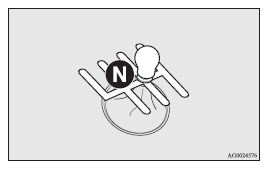Starting and stopping the

Tips for starting
• The operation mode can be in any mode to start the engine.
• The starter motor will be turning for up to approximately 15 seconds if the engine switch is released at once. Pressing the engine switch again while the starter motor is still turning will stop the starter motor. The starter motor will be turning for up to approximately 30 seconds while the engine switch is pressed.
If the engine does not start, wait for a while and then attempt to start the engine again. Trying repeatedly with the starter motor still running will damage the starter mechanism.
• [Diesel-powered vehicles] While the vehicle is stationary with the clutch pedal fully depressed, the engine revolutions do not rise to over 3,000 rpm in order to protect the engine even if the accelerator pedal is depressed.
![]() WARNING
WARNING
• Never run the engine in a closed or poorly ventilated area any longer than is needed to move your vehicle in or out of the area. Carbon monoxide gases are odourless and can be fatal.
![]() CAUTION
CAUTION
• Never attempt to start the engine by pushing or pulling the vehicle.
• Do not run the engine at high rpm or drive the vehicle at high speed until
the engine has had a chance to warm up.
Starting the engine (petrol-powered vehicles)
The starting procedure is as follows:
1. Fasten the seat belt.
2. Make sure the parking brake is applied.
3. Depress and hold the brake pedal.
4. Fully depress the clutch pedal (M/T).
![]() NOTE
NOTE
• On vehicles with the Auto Stop & Go (AS&G) system, the starter will not operate unless the clutch pedal is fully depressed (Clutch interlock).
5. On vehicles equipped with M/T, place the gearshift lever in the “N” (Neutral) position.
On vehicles equipped with CVT, make sure the selector lever is in the “P” (PARK) position.

![]() NOTE
NOTE
• The engine can only be started when the selector lever is in the “P” (PARK) or “N” (NEUTRAL) position (CVT).
For safety reasons, the engine should be started when the selector lever is in the “P” (PARK) position in which the driving wheels lock.
6. Press the engine switch.
7. Make sure that all warning lamps are functioning properly.
![]() NOTE
NOTE
• Minor noises may be heard on engine startup.
These will disappear as the engine warms up.
Starting the engine (diesel-powered vehicles)
1. Fasten the seat belt.
2. Make sure the parking brake is applied.
3. Depress and hold the brake pedal.
4. Fully depress and hold the clutch pedal.
![]() NOTE
NOTE
• On vehicles with the Auto Stop & Go (AS&G) system, the starter will not operate unless the clutch pedal is fully depressed (Clutch interlock).
5. Place the gearshift lever in the “N” (Neutral) position.

6. Press the engine switch.
The diesel preheat indication lamp will first illuminate, and then after a short time go out, indicating that preheating is completed. The engine will start.
![]() NOTE
NOTE
• If the engine is cold, the diesel preheat indication lamp is on for a longer time.
• Putting the operation mode in ON will also start preheating the engine. When the engine has not been started within about 5 seconds after the diesel preheat indication lamp went out, put the operation mode in OFF. Then, attempt the engine start procedure to preheat the engine again.
• Minor noises may be heard on engine startup.
These will disappear as the engine warms up.
See also:
Combination headlamps, dipper and turn signal switch
Headlamps
Rotate the switch to turn on the lamps.
–All lamps off
–Position, tail, licence–plate, and
instrument panel lamps on
–Headlamps on and other lamps remain
on
Lamp monitor ...
Automatic transmission INVECS–II 4A/T, Sports Mode 4A/T (Intelligent & Innovative
Vehicle Electronic Control System II)
Designed for optimum control and equipped with adaptive control capabilities,
the electronically controlled transmission optimally matches gear shifts to almost
all driving and road conditions.
C ...
Safety and disposal information for used engine oil
WARNING
• Prolonged and repeated contact may cause serious skin disorders, including
dermatitis and cancer.
• Avoid contact with the skin as far as possible and wash thoroughly after any
co ...
